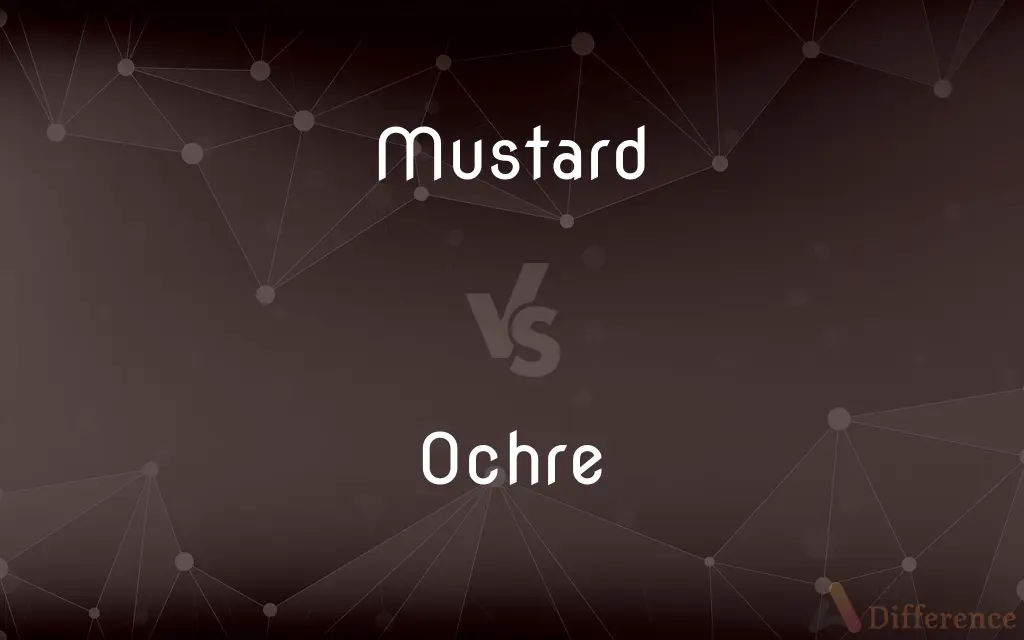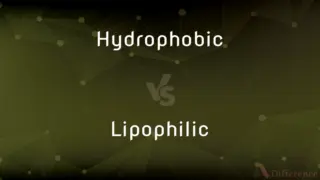Mustard vs. Ochre — What's the Difference?
By Urooj Arif & Maham Liaqat — Updated on March 11, 2024
Mustard is a bold, slightly bright yellow with a hint of green, often associated with the condiment. Ochre is a warm, earthy yellow with brown or red undertones, inspired by natural clay pigments.

Difference Between Mustard and Ochre
Table of Contents
ADVERTISEMENT
Key Differences
Mustard is a vibrant color often associated with energy and creativity, used in modern and eclectic designs. Whereas ochre is an earthy, natural tone that evokes a sense of warmth and stability, making it a favorite in rustic and heritage designs.
Mustard, with its brighter and slightly greenish undertones, is eye-catching and can add a pop of color to a space or outfit. On the other hand, ochre, with its muted warmth, tends to blend more seamlessly into natural settings or works of art.
In fashion, mustard is a statement color that stands out, especially in fall and winter collections. Ochre, meanwhile, is versatile and can be a subtle addition to any wardrobe, complementing a wide range of colors and seasons.
When it comes to interior design, mustard can be a bold choice for accent walls or decor items, infusing a lively vibe into the room. Ochre, with its soft and earthy hue, is often used for walls, textiles, and decorative elements to create a cozy and inviting atmosphere.
In the art world, mustard colors can bring a contemporary and dynamic feel to artworks, often used to capture attention and convey energy. Ochre has been used for centuries, valued for its natural and subdued qualities that provide a timeless appeal to paintings and pottery.
ADVERTISEMENT
Comparison Chart
Hue
Bold, slightly bright yellow
Warm, earthy yellow
Undertones
Hint of green
Brown or red
Associated Feel
Energy, creativity
Warmth, stability
Use in Design
Modern, eclectic
Rustic, heritage
Popularity in
Fashion, interior accents
Natural settings, art
Compare with Definitions
Mustard
A vibrant, slightly greenish yellow color.
The mustard curtains added a lively splash of color to the room.
Ochre
A natural earth pigment containing hydrated iron oxide.
Artists have used ochre for thousands of years because of its natural pigment.
Mustard
An adjective to describe a bold yellow color.
She chose a mustard dress to stand out at the party.
Ochre
An adjective to describe something of a warm, natural yellow hue.
The autumn leaves turned a beautiful ochre color.
Mustard
A condiment made from the seeds of a mustard plant.
She spread mustard on her sandwich for extra flavor.
Ochre
A warm, earthy yellow color with brown or red undertones.
The walls were painted a soft ochre to warm the room.
Mustard
A plant species whose seeds are used to make mustard condiment.
Mustard plants are easy to grow in a home garden.
Ochre
A color that mimics the hues of the natural earth.
The pottery was glazed in varying shades of ochre.
Mustard
A fabric dye color resembling the mustard plant.
His shirt was dyed a deep shade of mustard.
Ochre
Clay rich in hematite, used as a pigment.
Ochre was one of the first pigments used by humans in cave paintings.
Mustard
A hot-tasting yellow or brown paste made from the crushed seeds of certain plants, typically eaten with meat or used as a cooking ingredient
Dijon mustard
Mustard sauce
Ochre
Ochre ( OH-kər; from Ancient Greek: ὤχρα, from ὠχρός, ōkhrós, pale), or ocher in American English, is a natural clay earth pigment which is a mixture of ferric oxide and varying amounts of clay and sand. It ranges in colour from yellow to deep orange or brown.
Mustard
The yellow-flowered Eurasian plant of the cabbage family whose seeds are used to make mustard.
Ochre
An earthy pigment containing ferric oxide, typically with clay, varying from light yellow to brown or red
Yellow ochre
Mustard
A brownish yellow colour
A mustard sweater
Ochre
Variant of ocher.
Mustard
Any of various Eurasian plants of the mustard family, especially white mustard, Indian mustard, and black mustard, which are cultivated for their pungent seeds and edible leaves.
Ochre
An earth pigment containing silica, aluminum and ferric oxide
Mustard
A condiment made from the powdered seeds of certain of these plants.
Ochre
A somewhat dark yellowish orange colour
Mustard
A member of the mustard family.
Ochre
The stop codon sequence "UAA."
Mustard
A dark yellow to light olive brown.
Ochre
(slang) Money, especially gold.
Mustard
Any of a group of toxic organic compounds that include mustard gas and the nitrogen mustards.
Ochre
Any of various brown-coloured hesperiid butterflies of the genus Trapezites.
Mustard
A plant of certain species of the genus Brassica, or of related genera (especially Sinapis alba, in the family Brassicaceae, with yellow flowers, and linear seed pods).
Ochre
(obsolete) nodot=a.
Mustard
Powder or paste made from seeds of the mustard plant, and used as a condiment or a spice.
When the waitress brought the food, I asked whether she had any Dijon mustard.
Ochre
Having a yellow-orange colour.
Mustard
The leaves of the mustard plant, used as a salad.
Mustard and cress sandwiches.
Ochre
To cover or tint with ochre.
Mustard
Dark yellow colour, the colour of mustard.
Ochre
See Ocher.
Mustard
One of a family of vesicants containing one or more 2-chloroethyl (C2H4Cl) groups, commonly used in chemical warfare and cancer chemotherapy.
Ochre
Any of various earths containing silica and alumina and ferric oxide; used as a pigment
Mustard
The tomalley of a crab, which resembles the condiment.
Ochre
A moderate yellow-orange to orange color
Mustard
Of a dark yellow colour.
Ochre
Of a moderate orange-yellow color
Mustard
The name of several cruciferous plants of the genus Brassica (formerly Sinapis), as white mustard (Brassica alba), black mustard (Brassica Nigra), wild mustard or charlock (Brassica Sinapistrum).
Mustard
A powder or a paste made from the seeds of black or white mustard, used as a condiment and a rubefacient. Taken internally it is stimulant and diuretic, and in large doses is emetic.
Mustard
Any of several cruciferous plants of the genus Brassica
Mustard
Pungent powder or paste prepared from ground mustard seeds
Mustard
Leaves eaten as cooked greens
Common Curiosities
Is ochre a natural color?
Yes, ochre is a natural color derived from clay containing mineral oxides, traditionally used in art and decoration.
Can mustard and ochre be used together in design?
Yes, mustard and ochre can complement each other in design, offering a mix of vibrancy and earthy warmth.
Are there different shades of mustard and ochre?
Yes, both mustard and ochre have various shades, influenced by their specific undertones and intensity.
Which color is more versatile in fashion, mustard or ochre?
Ochre is considered more versatile in fashion due to its muted warmth, easily complementing a wide range of colors.
Which color is more common in natural landscapes, mustard or ochre?
Ochre is more common in natural landscapes, reflecting the earthy tones found in soil, rocks, and sand.
What historical significance does ochre have?
Ochre has historical significance as one of the first pigments used by humans in art, dating back to prehistoric cave paintings.
Can ochre be used in both traditional and modern designs?
Yes, ochre is versatile enough to be used in both traditional and modern designs, thanks to its warmth and natural appeal.
How does ochre differ from mustard in undertones?
Ochre has brown or red undertones, giving it a warm, earthy feel, whereas mustard has a hint of green, making it more vibrant.
What is mustard color inspired by?
Mustard color is inspired by the condiment made from mustard seeds, featuring a bold and slightly greenish yellow hue.
How do artists use mustard and ochre differently?
Artists use mustard for its boldness and energy, while ochre is chosen for its natural, timeless appeal.
Do mustard and ochre convey different emotions?
Yes, mustard often conveys energy and creativity, while ochre evokes warmth and stability.
Can both mustard and ochre be considered earth tones?
Ochre is typically considered an earth tone due to its natural origins, while mustard is sometimes seen as an earthy color when it has muted tones.
Is mustard suitable for all seasons in fashion?
Mustard is particularly popular in fall and winter fashion but can be adapted for other seasons depending on its shade and combination.
Do mustard and ochre have the same level of brightness?
Mustard is generally brighter with a slight vibrancy, whereas ochre is more subdued and muted.
Which color is easier to integrate into interior design, mustard or ochre?
Ochre is often considered easier to integrate into interior design due to its natural, warm tone that complements a variety of styles and colors.
Share Your Discovery

Previous Comparison
Dynamic vs. Forceful
Next Comparison
Hydrophobic vs. LipophilicAuthor Spotlight
Written by
Urooj ArifUrooj is a skilled content writer at Ask Difference, known for her exceptional ability to simplify complex topics into engaging and informative content. With a passion for research and a flair for clear, concise writing, she consistently delivers articles that resonate with our diverse audience.
Co-written by
Maham Liaqat













































